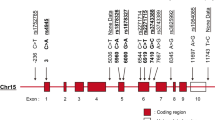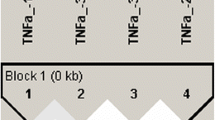Abstract
Elevated concentrations of inflammatory mediators are characteristic of autoimmune disease accompanied by chronic or recurrent inflammation. We examined the hypothesis that mediators of inflammation known to be elevated in systemic lupus erythematosus (SLE) and rheumatoid arthritis (RA) are associated with genetic polymorphism previously identified in studies of inflammatory disease. Serum interleukin 6 (IL-6) and tumor necrosis factor alpha (TNFα) concentrations in patients with SLE (n = 117) or RA (n = 164) and in inflammatory disease-free control subjects (n = 172) were measured by multiplex ELISA. Candidate genes were chosen from studies of autoimmune and inflammatory disease. Genotypes were determined for 345 SNP markers in 75 genes. Association between serum analytes and single alleles was tested by linear regression. Polymorphisms in several genes were associated with IL-6 levels (including IL10, TYK2, and CD40L in SLE and DRB1, NOD2, and CSF1 in RA) or with TNFα levels (including TNFSF4 and CSF2 in SLE and PTPN2, DRB1, and NOD2 in RA). Some associations were shared between disease and control groups or between IL-6 and TNFα within a group. In conclusion, variation in genes implicated in disease pathology is associated with serum IL-6 or TNFα concentration. Some genetic associations are more apparent in healthy controls than in SLE or RA, suggesting dysregulation of the principal mediators of chronic inflammation in disease. Susceptibility genes may affect inflammatory response with variable effect on disease etiology.
Similar content being viewed by others
References
Tsokos GC (2011) Systemic lupus erythematosus. N Engl J Med 365(22):2110–2121
Scott DL, Wolfe F, Huizinga TW (2010) Rheumatoid arthritis. Lancet 376(9746):1094–1108
Cho JH, Gregersen PK (2011) Genomics and the multifactorial nature of human autoimmune disease. N Engl J Med 365(17):1612–1623
Yap DY, Lai KN (2010) Cytokines and their roles in the pathogenesis of systemic lupus erythematosus: from basics to recent advances. J Biomed Biotechnol 2010:365083
McInnes IB, Schett G (2007) Cytokines in the pathogenesis of rheumatoid arthritis. Nat Rev Immunol 7(6):429–442
Sanchez E, Nadig A, Richardson BC et al (2011) Phenotypic associations of genetic susceptibility loci in systemic lupus erythematosus. Ann Rheum Dis 70(10):1752–1757
Zhernakova A, van Diemen CC, Wijmenga C (2009) Detecting shared pathogenesis from the shared genetics of immune-related diseases. Nat Rev Genet 10(1):43–55
Maier LM, Hafler DA (2009) Autoimmunity risk alleles in costimulation pathways. Immunol Rev 229(1):322–336
Shah T, Zabaneh D, Gaunt T et al (2013) Gene-centric analysis identifies variants associated with interleukin-6 levels and shared pathways with other inflammation markers. Circ Cardiovasc Genet 6(2):163–170
Weinstock M, Grimm I, Dreier J, Knabbe C, Vollmer T (2014) Genetic variants in genes of the inflammatory response in association with infective endocarditis. PLoS One 9(10):e110151
Vaughn CB, Ochs-Balcom HM, Nie J et al (2013) No association between circulating levels and genetic variants of IL-6 and TNF-alpha and colon adenoma. Gastroenterol Res 6(2)
Tan EM, Cohen AS, Fries JF et al (1982) The 1982 revised criteria for the classification of systemic lupus erythematosus. Arthritis Rheum 25(11):1271–1277
Arnett FC, Edworthy SM, Bloch DA et al (1988) The American Rheumatism Association 1987 revised criteria for the classification of rheumatoid arthritis. Arthritis Rheum 31:315–324
Asanuma Y (2003) Premature coronary-artery atherosclerosis in systemic lupus erythematosus. N Engl J Med 349:2407–2415
Chung CP, Oeser A, Raggi P et al (2005) Increased coronary-artery atherosclerosis in rheumatoid arthritis: relationship to disease duration and cardiovascular risk factors. Arthritis Rheum 52:3045–3053
Rho YH (2011) Macrophage activation and coronary atherosclerosis in systemic lupus erythematosus and rheumatoid arthritis. Arthritis Care Res (Hoboken) 63:535–541
Chung CP, Oeser A, Solus JF et al (2008) Inflammation-associated insulin resistance: differential effects in rheumatoid arthritis and systemic lupus erythematosus define potential mechanisms. Arthritis Rheum 58(7):2105–2112
Rho YH, Solus J, Sokka T et al (2009) Adipocytokines are associated with radiographic joint damage in rheumatoid arthritis. Arthritis Rheum 60(7):1906–1914
Rho YH, Chung CP, Oeser A et al (2008) Novel cardiovascular risk factors in premature coronary atherosclerosis associated with systemic lupus erythematosus. J Rheumatol 35(9):1789–1794
Prevoo ML, van ’t Hof MA, Kuper HH, van Leeuwen MA, Van de Putte LB, Van Riel PL (1995) Modified disease activity scores that include twenty-eight-joint counts. Development and validation in a prospective longitudinal study of patients with rheumatoid arthritis. Arthritis Rheum 38:44–48
Bombardier C, Gladman DD, Urowitz MB, Caron D, Chang CH (1992) Derivation of the SLEDAI. A disease activity index for lupus patients. The Committee on Prognosis Studies in SLE. Arthritis Rheum 35(6):630–640
Schnabel RB, Lunetta KL, Larson MG et al (2009) The relation of genetic and environmental factors to systemic inflammatory biomarker concentrations. Circ Cardiovasc Genet 2(3):229–237
Raychaudhuri S, Sandor C, Stahl EA et al (2012) Five amino acids in three HLA proteins explain most of the association between MHC and seropositive rheumatoid arthritis. Nat Genet 44(3):291–296
Cooles FA, Isaacs JD (2011) Pathophysiology of rheumatoid arthritis. Curr Opin Rheumatol 23(3):233–240
van der Helm-van Mil AH, Huizinga TW (2008) Advances in the genetics of rheumatoid arthritis point to subclassification into distinct disease subsets. Arthritis Res Ther 10(2):205
du Montcel ST, Michou L, Petit-Teixeira E et al (2005) New classification of HLA-DRB1 alleles supports the shared epitope hypothesis of rheumatoid arthritis susceptibility. Arthritis Rheum 52(4):1063–1068
Samet JM, Tal TL (2010) Toxicological disruption of signaling homeostasis: tyrosine phosphatases as targets. Annu Rev Pharmacol Toxicol 50:215–235
Dube N, Tremblay ML (2005) Involvement of the small protein tyrosine phosphatases TC-PTP and PTP1B in signal transduction and diseases: from diabetes, obesity to cell cycle, and cancer. Biochim Biophys Acta 1754(1–2):108–117
Lees CW, Barrett JC, Parkes M, Satsangi J (2011) New IBD genetics: common pathways with other diseases. Gut 60(12):1739–1753
Scharl M, Paul G, Weber A et al (2009) Protection of epithelial barrier function by the Crohn’s disease associated gene protein tyrosine phosphatase n2. Gastroenterology 137(6):2030–2040
Scharl M, Mwinyi J, Fischbeck A et al (2012) Crohn’s disease-associated polymorphism within the PTPN2 gene affects muramyl-dipeptide-induced cytokine secretion and autophagy. Inflamm Bowel Dis 18(5):900–912
Doody KM, Bourdeau A, Tremblay ML (2009) T-cell protein tyrosine phosphatase is a key regulator in immune cell signaling: lessons from the knockout mouse model and implications in human disease. Immunol Rev 228(1):325–341
Hassan SW, Doody KM, Hardy S, Uetani N, Cournoyer D, Tremblay ML (2010) Increased susceptibility to dextran sulfate sodium induced colitis in the T cell protein tyrosine phosphatase heterozygous mouse. PLoS One 5(1):e8868
Yamamoto T, Sekine Y, Kashima K et al (2002) The nuclear isoform of protein-tyrosine phosphatase TC-PTP regulates interleukin-6-mediated signaling pathway through STAT3 dephosphorylation. Biochem Biophys Res Commun 297(4):811–817
Vanden Berghe W, Vermeulen L, De WG, De BK, Boone E, Haegeman G (2000) Signal transduction by tumor necrosis factor and gene regulation of the inflammatory cytokine interleukin-6. Biochem Pharmacol 60(8):1185–1195
Chen G, Shaw MH, Kim YG, Nunez G (2009) NOD-like receptors: role in innate immunity and inflammatory disease. Annu Rev Pathol 4:365–398
Zhu S, Qian Y (2012) IL-17/IL-17 receptor system in autoimmune disease: mechanisms and therapeutic potential. Clin Sci (Lond) 122(11):487–511
Hume DA, MacDonald KP (2012) Therapeutic applications of macrophage colony-stimulating factor-1 (CSF-1) and antagonists of CSF-1 receptor (CSF-1R) signaling. Blood 119(8):1810–1820
Ramos PS, Criswell LA, Moser KL et al (2011) A comprehensive analysis of shared loci between systemic lupus erythematosus (SLE) and sixteen autoimmune diseases reveals limited genetic overlap. PLoS Genet 7(12):e1002406
Orozco G, Eyre S, Hinks A et al (2011) Study of the common genetic background for rheumatoid arthritis and systemic lupus erythematosus. Ann Rheum Dis 70(3):463–468
Gateva V, Sandling JK, Hom G et al (2009) A large-scale replication study identifies TNIP1, PRDM1, JAZF1, UHRF1BP1 and IL10 as risk loci for systemic lupus erythematosus. Nat Genet 41(11):1228–1233
Cunninghame Graham DS, Morris DL, Bhangale TR et al (2011) Association of NCF2, IKZF1, IRF8, IFIH1, and TYK2 with systemic lupus erythematosus. PLoS Genet 7(10):e1002341
Budarf ML, Goyette P, Boucher G et al (2011) A targeted association study in systemic lupus erythematosus identifies multiple susceptibility alleles. Genes Immun 12(1):51–58
Oxer DS, Godoy LC, Borba E et al (2011) PPARgamma expression is increased in systemic lupus erythematosus patients and represses CD40/CD40L signaling pathway. Lupus 20(6):575–587
Savitsky D, Tamura T, Yanai H, Taniguchi T (2010) Regulation of immunity and oncogenesis by the IRF transcription factor family. Cancer Immunol Immunother 59(4):489–510
Tada Y, Kondo S, Aoki S et al (2011) Interferon regulatory factor 5 is critical for the development of lupus in MRL/lpr mice. Arthritis Rheum 63(3):738–748
Panchanathan R, Liu H, Liu H et al (2012) Distinct regulation of murine lupus susceptibility genes by the IRF5/Blimp-1 axis. J Immunol 188(1):270–278
Feng D, Stone RC, Eloranta ML et al (2010) Genetic variants and disease-associated factors contribute to enhanced interferon regulatory factor 5 expression in blood cells of patients with systemic lupus erythematosus. Arthritis Rheum 62(2):562–573
Yasuda K, Richez C, Maciaszek JW et al (2007) Murine dendritic cell type I IFN production induced by human IgG-RNA immune complexes is IFN regulatory factor (IRF)5 and IRF7 dependent and is required for IL-6 production. J Immunol 178(11):6876–6885
Yanai H, Chen HM, Inuzuka T et al (2007) Role of IFN regulatory factor 5 transcription factor in antiviral immunity and tumor suppression. Proc Natl Acad Sci U S A 104(9):3402–3407
Stanford SM, Mustelin TM, Bottini N (2010) Lymphoid tyrosine phosphatase and autoimmunity: human genetics rediscovers tyrosine phosphatases. Semin Immunopathol 32(2):127–136
Burn GL, Svensson L, Sanchez-Blanco C, Saini M, Cope AP (2011) Why is PTPN22 a good candidate susceptibility gene for autoimmune disease? FEBS Lett 585(23):3689–3698
Siasos G, Tousoulis D, Kioufis S et al (2012) Inflammatory mechanisms in atherosclerosis: the impact of matrix metalloproteinases. Curr Top Med Chem 12(10):1132–1148
Dai C, Deng Y, Quinlan A, Gaskin F, Tsao BP, Fu SM (2014) Genetics of systemic lupus erythematosus: immune responses and end organ resistance to damage. Curr Opin Immunol 31C:87–96
Fu Q, Zhao J, Qian X et al (2011) Association of a functional IRF7 variant with systemic lupus erythematosus. Arthritis Rheum 63(3):749–754
Sources of funding
This study was supported by NIH grants HL65082, HL67964, GM07569, 2UL1 TR00044506, P60 AR056116, K23AR064768, the Vanderbilt Physician Scientist Development award, and the Dan May Chair in Medicine.
Conflict of interest
None of the authors has a conflict of interest related to this work.
Author information
Authors and Affiliations
Corresponding author
Electronic supplementary material
Below is the link to the electronic supplementary material.
Supplementary Table 1
(PDF 181 kb)
Supplementary Table 2
(PDF 162 kb)
Rights and permissions
About this article
Cite this article
Solus, J.F., Chung, C.P., Oeser, A. et al. Genetics of serum concentration of IL-6 and TNFα in systemic lupus erythematosus and rheumatoid arthritis: a candidate gene analysis. Clin Rheumatol 34, 1375–1382 (2015). https://doi.org/10.1007/s10067-015-2881-6
Received:
Revised:
Accepted:
Published:
Issue Date:
DOI: https://doi.org/10.1007/s10067-015-2881-6




